Robbery rates in the Third MPD District – comparing PSAs
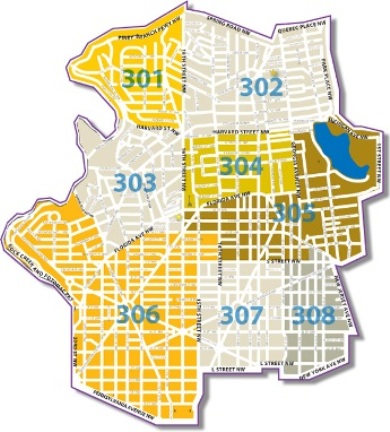
Of course everyone worries about robberies, the crime of violence that most seriously
threatens innocent residents. And everyone tends to think that the robbery
problem is worse in one's own neighborhood than anywhere else. What's the
reality, in the Third Police District, covering inner-city neighborhoods from
Mount Pleasant to Shaw?
This chart shows robbery rates, in reported
robberies per month per 1000 residents , thus providing a fair
comparison for PSAs of different sizes. This is for the time period January
through September, 2008. Perhaps surprisingly, Mount Pleasant has a
robbery-per-resident rate that is not only the lowest in the Third District, but
below the average for the District (DC).
Not so surprisingly, Columbia
Heights (PSA 302) is high on the list, with a robbery-per-resident rate that is
roughly three times that which prevails in Mount Pleasant, and is well above the
average for the Third District, as
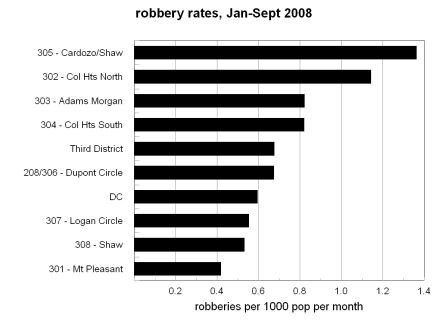 well as higher than the DC average.
well as higher than the DC average.
PSA 305, Cardozo/Shaw/U Street, has the unhappy distinction of
having the highest robbery-per-resident rate of the area.
I include Dupont
Circle on the list, because it used to be in the Third
District (PSA 306), and is an inner-city gentrification neighborhood, somewhat like
Mount Pleasant, Logan Circle, Adams Morgan, and, in part, Columbia Heights.
In September, 2007, Dupont Circle was shifted into the Second District, becoming PSA 208, to reduce
the crime overload for the MPD in the Third District, and give the officers in
2D something to do. Crime is so scarce in 2D that the officers posted there are
belittled as "squirrel chasers" by MPD officers in the rest of the
city.
The
comparison of these several inner-city gentrification neighborhoods is
instructive:
Mount Pleasant, Logan
Circle, Dupont Circle, and Adams Morgan, have robbery-per-resident rates not far
from the District average. They do tend to get more attention from politicians
and the police than tougher neighborhoods, such as Columbia Heights, perhaps
because the residents of these neighborhoods are quicker and more forceful at
calling on the authorities for measures to reduce crime. In Columbia Heights,
old-time residents may shrug off robberies as an unfortunate part of life in the
inner city. The influx of "gentry" into the neighborhood is changing that, as
the newer residents are not so inured to the threat of robberies as an
unavoidable fact of life.
Old-time residents
of Mount Pleasant, especially those on the eastern edge, bordering
Columbia Heights, are commonly shocked at the way newer residents can be oblivious to
the threat of robbery. Old-time residents walk with alertness to the
threat. Newcomers sometimes walk while chatting in cellphones, or with iPods
plugged into their ears, ignoring all that is going on around them. That's an
invitation to a would-be robber to follow such a person onto side streets,
hoping for a moment with no one else around, for a chance to
attack.
Robberies tend to come in waves.
In part, it's a matter of the weather, as summertime brings out people, and
robbers to prey on them. In part, this is driven by need; the police assert
that robberies increase just before Christmas and other gift-giving holidays.
And in part, the variations are the normal behavior of small-number statistics.
When incidents happen in small numbers, random variations can produce large
apparent changes.
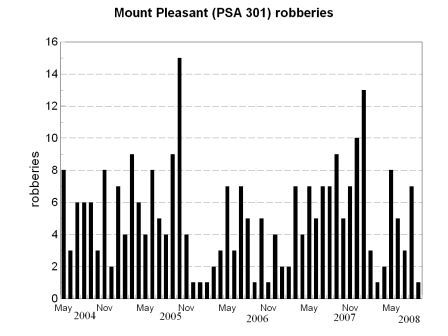
The chart of reported robberies in Mount
Pleasant since 2004 (the current PSAs were formed in May of that year) displays
the sharp variations that happen, month to month.
Some of the dramatic peaks are real, as bands of
robbers target the neighborhood; this happened in October 2005, and again in
January 2008. Police work has been effective at putting a stop to such
predation. But other variations, from one in a month to eight or nine,
are (I believe) merely the usual "noise" in small, random numbers. When the
count drops to a very low value, not infrequently just one robbery in a month,
that's not because the police are suddenly doing something effective. It's just
the noise of small-number statistics, in this case, as the juveniles (the
usual perpetrators) who commit these acts wander around the area, and as they
become more or less enthusiastic about their little
pastime.
Recently Adams Morgan has come in for close attention, including
a press conference by Councilmember Jim Graham and Police Chief Lanier at the
intersection of Columbia Road and 18th Street. Was this in response to a real
crime wave, or just a "normal" spike?
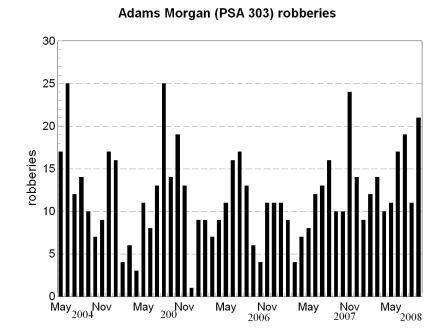
Here's the chart for Adams Morgan, showing that robberies have risen recently
(September 2008).
Some residents complain that the robbery
count has doubled, August to September, as if that datum alone proves that a
crime wave is under way. In fact, robbery counts over 20 in a month have been
observed before, and the September count is not as high as has been seen before.
Whether this is a "noise" spike in the robbery rate, or a true sign of a number
of robbers targeting Adams Morgan, is impossible to say from statistics
alone.
It is curious that, while the robbery rate in Adams Morgan
increased to a high value, the robbery rate in Mount Pleasant dropped to almost
zero. (The one robbery in Mount Pleasant in September was a purse snatch,
executed by a guy jumping out of a car on Irving Street, an unusual technique,
and not at all resembling the Adams Morgan robberies.) In earlier cases there
have been correlations, as the roaming bands of youths perpetrating robberies
crossed Harvard Street into Mount Pleasant.
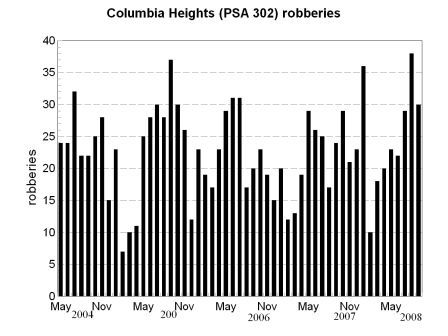 Columbia Heights shows an example of a true,
"secular" increase in robbery rates, not just a random variation
. The robbery count increases rapidly from February 2008 forward,
reaching an all-time peak of 38 robberies reported in August, 2008. The
statistics cannot tell us whether this is a real change, or statistical noise,
but the MPD reports that there has been a marked incidence of robbers preying
upon Latino men on the street. Such men are favored victims, because they're
known for carrying large amounts of cash, commonly having no bank accounts.
Happily, the police are focusing resources on this problem, including calling
upon Latino organizations to assist in persuading Latinos to put their cash in
bank accounts, rather than carrying it around. But there's been no on-the-street
press conference, featuring politicians and high-level police officials, to
promise efforts to stop the robberies.
Columbia Heights shows an example of a true,
"secular" increase in robbery rates, not just a random variation
. The robbery count increases rapidly from February 2008 forward,
reaching an all-time peak of 38 robberies reported in August, 2008. The
statistics cannot tell us whether this is a real change, or statistical noise,
but the MPD reports that there has been a marked incidence of robbers preying
upon Latino men on the street. Such men are favored victims, because they're
known for carrying large amounts of cash, commonly having no bank accounts.
Happily, the police are focusing resources on this problem, including calling
upon Latino organizations to assist in persuading Latinos to put their cash in
bank accounts, rather than carrying it around. But there's been no on-the-street
press conference, featuring politicians and high-level police officials, to
promise efforts to stop the robberies.
It's regrettable, to be sure, but
it's clear: "gentry" becoming crime victims counts for more than immigrant
laborers, at least for the political powers. The police are, I believe, very
attentive to all crime problems, regardless of the social status of the victims.
Or they try to be, but political pressures can be troublesome to them, too,
despite their best efforts to be fair to all residents.
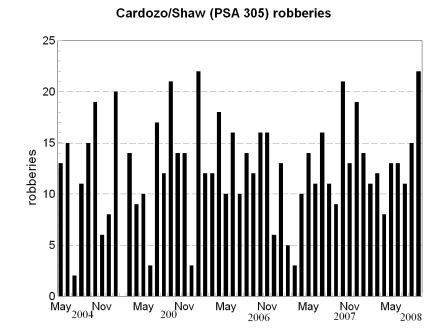 What about PSA 305, Cardozo/Shaw, which has the highest per-resident
rate of robberies in the Third District?
The robbery count there surged in September
as well, to a level matching the previous record high. As is evident from
the chart, the statistical noise is large. But PSA 305 has, on the average, a
higher robberies-per-resident rate than Columbia Heights, and much higher (60%) than
Adams Morgan. But this seems to get much less attention than robberies in PSAs
on the west side of the Third District. Like Adams Morgan, it has a very
active nightlife, sharply increasing the number of potential
victims.
What about PSA 305, Cardozo/Shaw, which has the highest per-resident
rate of robberies in the Third District?
The robbery count there surged in September
as well, to a level matching the previous record high. As is evident from
the chart, the statistical noise is large. But PSA 305 has, on the average, a
higher robberies-per-resident rate than Columbia Heights, and much higher (60%) than
Adams Morgan. But this seems to get much less attention than robberies in PSAs
on the west side of the Third District. Like Adams Morgan, it has a very
active nightlife, sharply increasing the number of potential
victims.
What should the police be doing? I think the current 3D
Commander has it right: "I had undercover officers this weekend that did patrol
the surrounding the neighborhood. That said, 18th Street does require
police presence due to the size of the crowd and the fact that there have been
assaults and other crimes to include robbery" (Cmdr Kucik to the MPD-3D Yahoo site, October 13, 2008).
Essentially, deploy uniformed officers to busy streets to control crowds, and post plainclothes officers on side streets to watch for would-be robbers.
Disorderly conduct is best controlled by officers in uniform, imposing authority on the
street; robbers are best caught, and/or deterred, by officers who are invisible, allowing
the perps to do their thing with a false sense of security. That's
good police strategy.
Return to home
Page created October 13,
2008

 well as higher than the DC average.
well as higher than the DC average.

 Columbia Heights shows an example of a true,
"secular" increase in robbery rates, not just a random variation
. The robbery count increases rapidly from February 2008 forward,
reaching an all-time peak of 38 robberies reported in August, 2008. The
statistics cannot tell us whether this is a real change, or statistical noise,
but the MPD reports that there has been a marked incidence of robbers preying
upon Latino men on the street. Such men are favored victims, because they're
known for carrying large amounts of cash, commonly having no bank accounts.
Happily, the police are focusing resources on this problem, including calling
upon Latino organizations to assist in persuading Latinos to put their cash in
bank accounts, rather than carrying it around. But there's been no on-the-street
press conference, featuring politicians and high-level police officials, to
promise efforts to stop the robberies.
Columbia Heights shows an example of a true,
"secular" increase in robbery rates, not just a random variation
. The robbery count increases rapidly from February 2008 forward,
reaching an all-time peak of 38 robberies reported in August, 2008. The
statistics cannot tell us whether this is a real change, or statistical noise,
but the MPD reports that there has been a marked incidence of robbers preying
upon Latino men on the street. Such men are favored victims, because they're
known for carrying large amounts of cash, commonly having no bank accounts.
Happily, the police are focusing resources on this problem, including calling
upon Latino organizations to assist in persuading Latinos to put their cash in
bank accounts, rather than carrying it around. But there's been no on-the-street
press conference, featuring politicians and high-level police officials, to
promise efforts to stop the robberies.  What about PSA 305, Cardozo/Shaw, which has the highest per-resident
rate of robberies in the Third District?
The robbery count there surged in September
as well, to a level matching the previous record high. As is evident from
the chart, the statistical noise is large. But PSA 305 has, on the average, a
higher robberies-per-resident rate than Columbia Heights, and much higher (60%) than
Adams Morgan. But this seems to get much less attention than robberies in PSAs
on the west side of the Third District. Like Adams Morgan, it has a very
active nightlife, sharply increasing the number of potential
victims.
What about PSA 305, Cardozo/Shaw, which has the highest per-resident
rate of robberies in the Third District?
The robbery count there surged in September
as well, to a level matching the previous record high. As is evident from
the chart, the statistical noise is large. But PSA 305 has, on the average, a
higher robberies-per-resident rate than Columbia Heights, and much higher (60%) than
Adams Morgan. But this seems to get much less attention than robberies in PSAs
on the west side of the Third District. Like Adams Morgan, it has a very
active nightlife, sharply increasing the number of potential
victims.